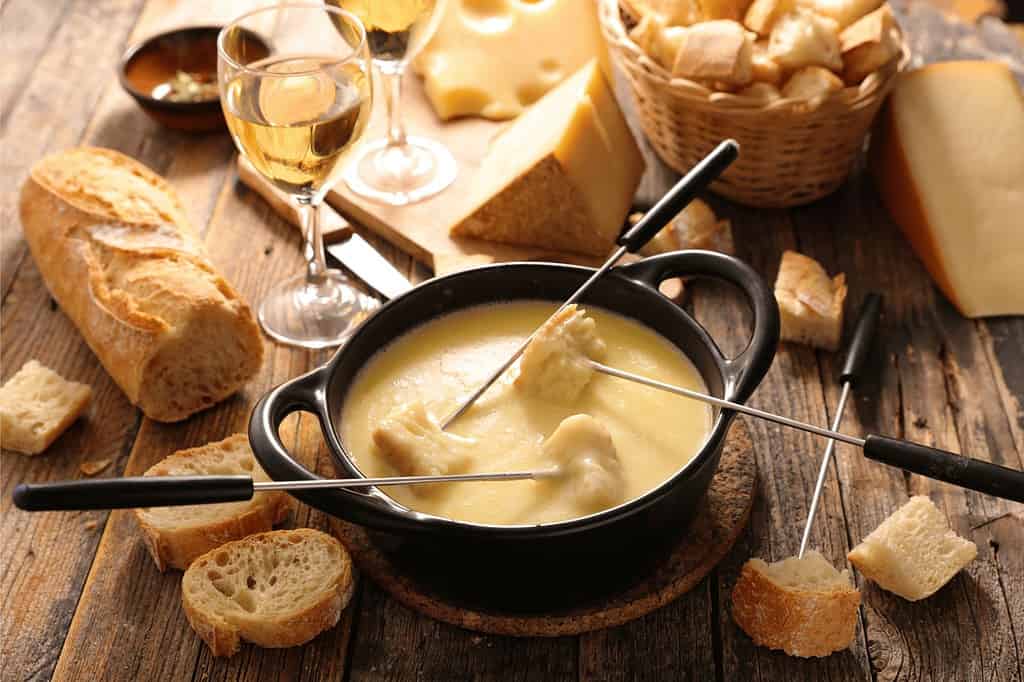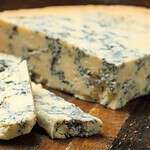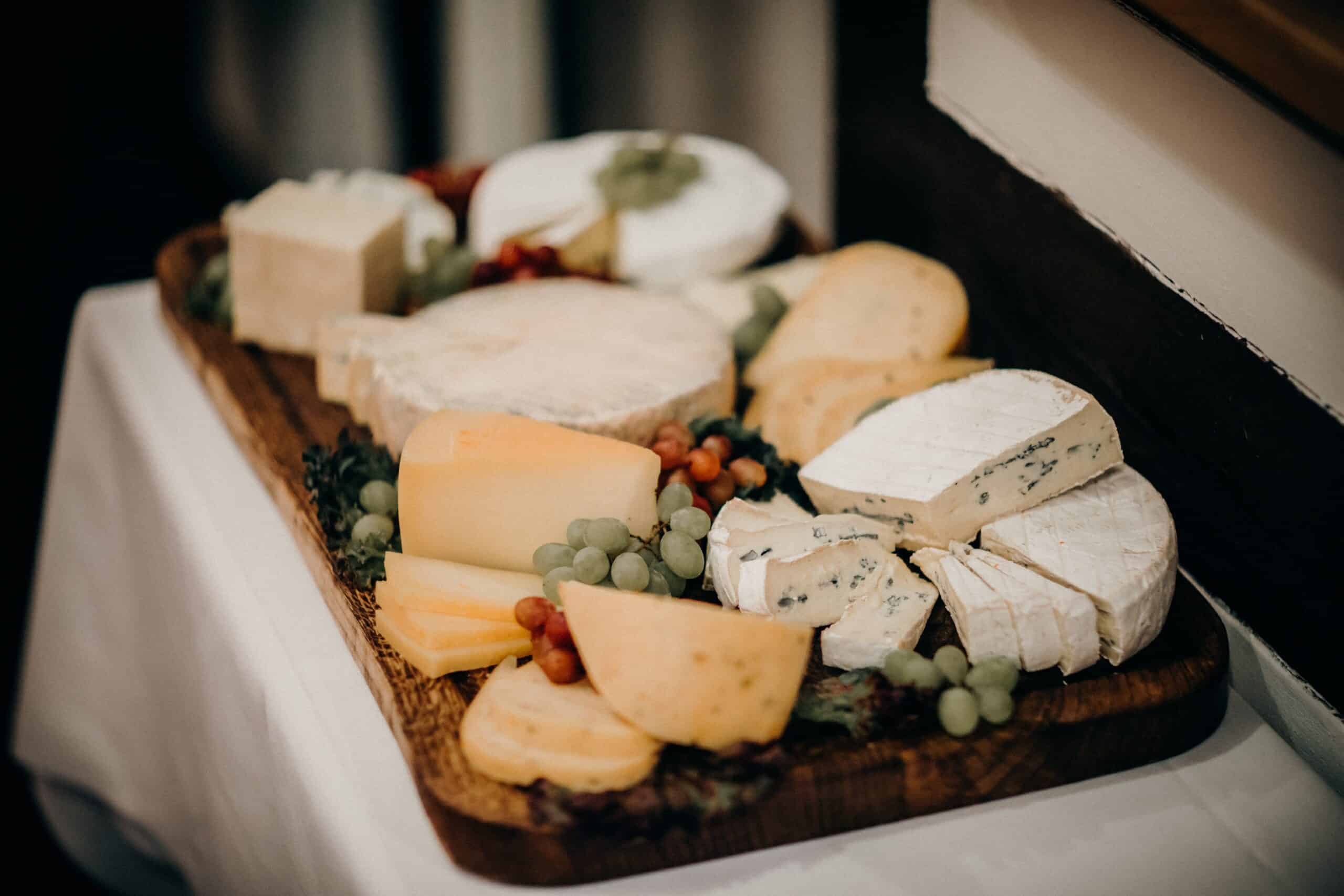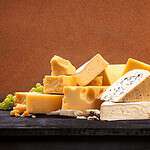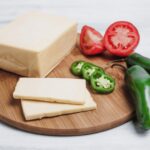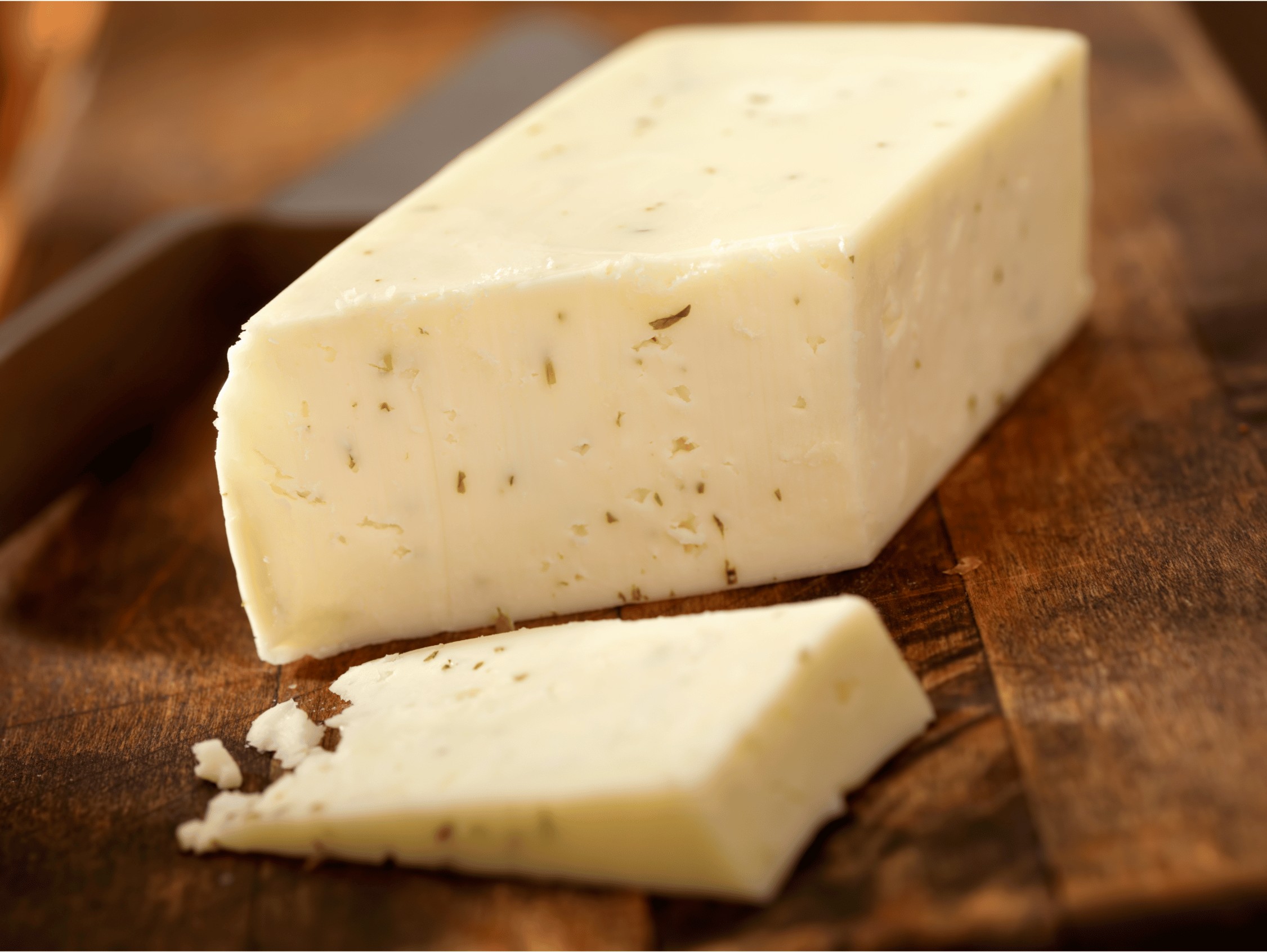Cheese fondue presents a delectable opportunity for communal dining, offering a warm and gooey centerpiece for a variety of dippables. At its heart, fondue is a simple dish — melted cheese into which we dip our chosen morsels. But the true delight of fondue lies in the wide array of foods that can be dipped, each bringing textures and flavors to complement the richness of the cheese.
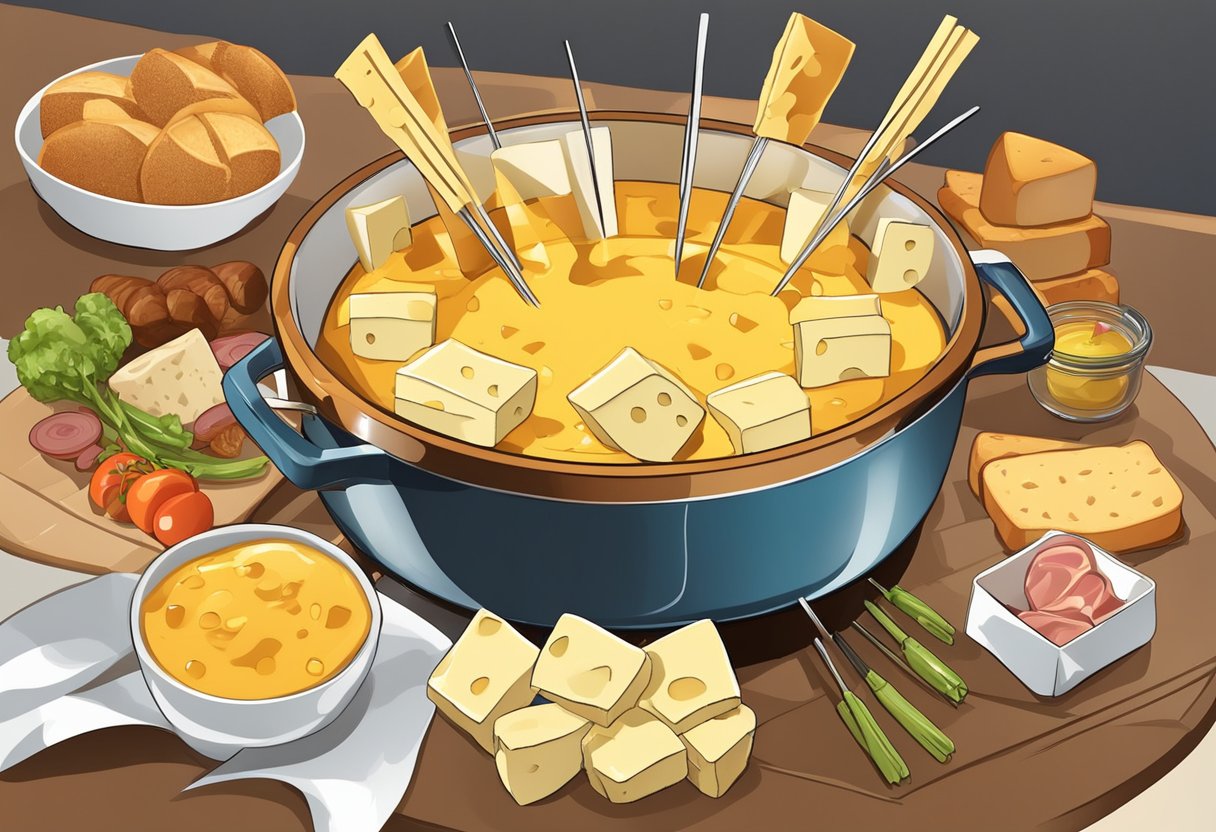
Traditionally, we reach for pieces of bread with a sturdy crust to withstand a dive into the cheese. But the fondue experience doesn’t end there. Beyond the bread, we venture into a plethora of other foods like vegetables, meats, and even fruits, finding that nearly anything can be enhanced by a cheesy coating. Our choices can be tailored to fit the occasion, whether it’s an elegant gathering or a casual get-together, each item enhancing the overall fondue experience and offering a satisfying contrast to the creamy dip.
Key Takeaways
- Cheese fondue serves as a versatile centerpiece for a variety of dipping items.
- Bread, meats, vegetables, and fruits are popular choices to dip in cheese fondue.
- The selection of dippables can be customized to suit any type of gathering or preference.
Understanding Cheese Fondue
In approaching cheese fondue, we appreciate its storied past, master the essential ingredients, understand the pivotal role of cheese, and choose the right fondue pot for a successful culinary experience.
History of Cheese Fondue
The tradition of cheese fondue began in Switzerland during the 18th century. Originally a means for peasants to use aged cheeses and hard bread during winter months, this dish has transcended its humble origins to become a beloved centerpiece at social gatherings.
Ingredients of Traditional Cheese Fondue
A classic cheese fondue recipe calls for a blend of quality Swiss cheeses—typically Gruyère and Emmental—combined with dry white wine to achieve a smooth consistency. The mixture is seasoned with garlic, a hint of nutmeg, and often a splash of kirsch, a cherry brandy, for added depth of flavor.
The Role of Cheese in Fondue
The choice of cheese heavily influences the texture and taste of the fondue. Gruyère provides a rich, creamy base with a slightly nutty flavor, while Emmental contributes to the smooth meltability and imparts a milder, buttery note. It’s crucial that these cheeses balance each other for an optimal fondue.
Selecting the Right Fondue Pot
For an authentic experience and optimal heat distribution, we opt for a ceramic or cast iron fondue pot. The pot should maintain a consistent, gentle heat to keep the cheese at the perfect temperature—warm enough to stay melted without scorching.
Preparing for A Fondue Party
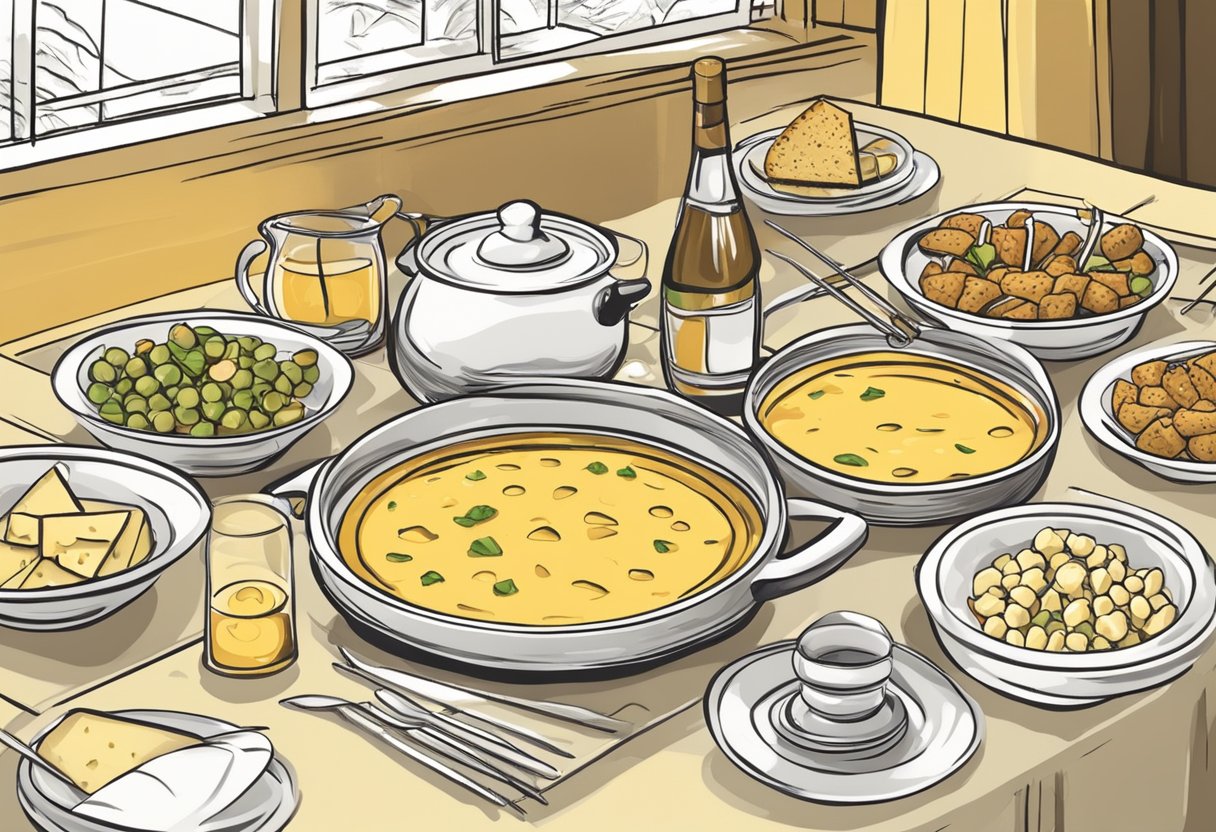
We’ll focus on the essentials for our fondue party: setting a welcoming table and choosing a variety of dippers.
Setting the Table
Before guests arrive, we ensure the fondue pot is the centerpiece of our table, within easy reach of every seat. We arrange seats to encourage interaction and allocate adequate space for our guests to maneuver their fondue forks without crossing arms. A tablecloth is optional, but placemats can help manage drips or spills. Furthermore, providing individual plates and napkins is a must for personal use.
- Tableware:
- Fondue pot placed centrally
- Plates and napkins for each guest
- Fondue forks: one set for each type of dipper
Arranging Dipping Ingredients
The success of a cheese fondue party often lies in the variety of dippers provided. We ensure a balance of flavors and textures to cater to all palates. Here are our go-to dippers:
Breads:
- Cubes of French baguette
- Pieces of focaccia or ciabatta
Vegetables:
- Bell pepper strips
- Steamed broccoli florets
- Cherry tomatoes
Proteins:
- Cooked sausage slices
- Boiled baby potatoes
- Cubed grilled chicken
Each dipper is conveniently cut into bite-sized pieces and arrayed on separate platters. We arrange them around the fondue pot for easy access. Our careful preparation ensures a smooth and delightful fondue experience.
Bread Varieties for Dipping
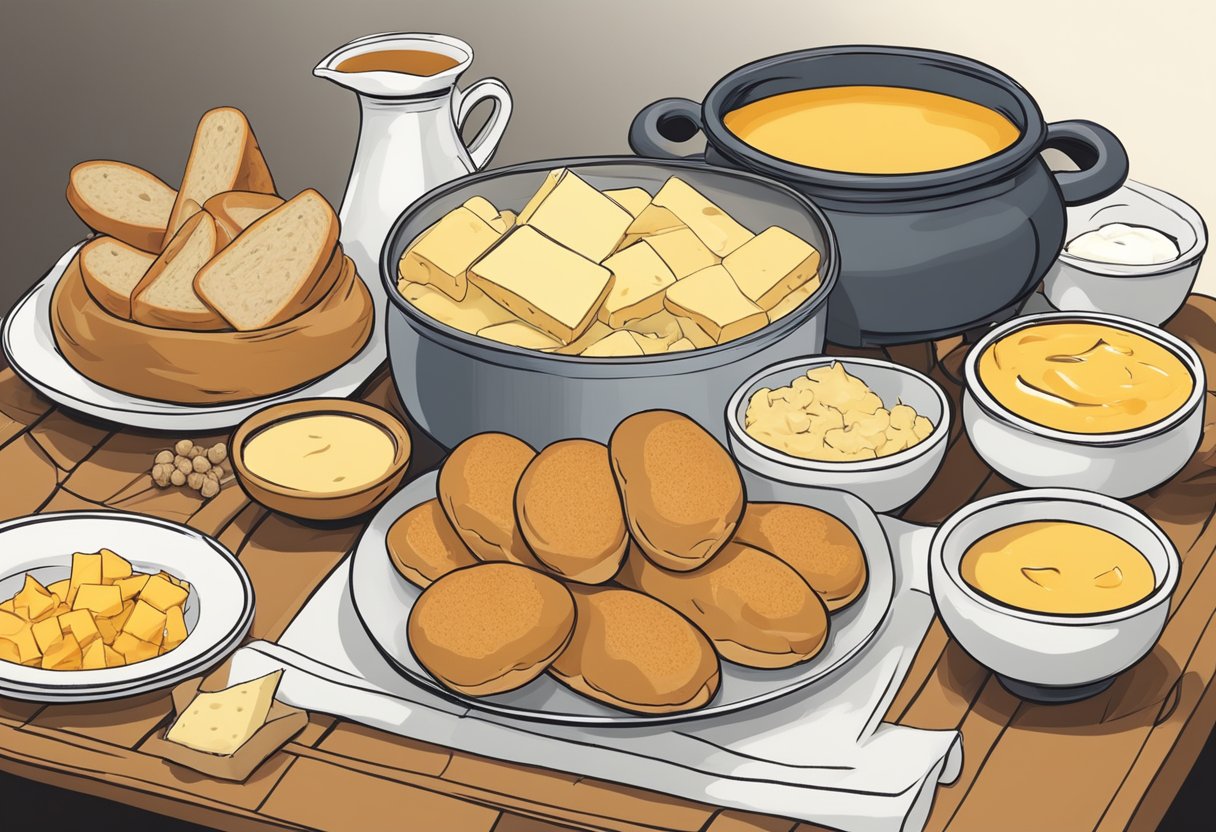
When we prepare cheese fondue, the choice of bread we dip into it is crucial for the overall experience. The ideal candidates are bread that can hold up to the cheese without falling apart. Here’s a list of breads we recommend:
- Sourdough Bread: Its dense texture and slight tang complement the rich, melted cheese exceptionally well.
- Baguette: This French bread is a classic choice. We suggest toasting it lightly to add a pleasant crunch.
- Rye Bread: Its distinctive flavor pairs well with stronger cheeses and adds an interesting twist to the fondue.
Additionally, here’s a quick table to guide our selections:
| Bread Type | Description | Suggested Cheese Pairing |
|---|---|---|
| Sourdough | Dense and tangy, holds up well | Gruyere, Emmental |
| Baguette | Crusty outside, soft inside, classic | Brie, Camembert |
| French Bread | Similar to baguette, but softer | Roquefort, Goat cheese |
| Rye | Hearty with a distinct flavor | Cheddar, Gouda |
| Crackers | Crisp and neutral, good for texture | Swiss, Havarti |
Do remember that for a good fondue experience, the bread should be cut into bite-sized cubes, allowing for easy spearing and dipping. We also find that day-old bread works best as it’s slightly drier, which helps it soak up the cheese without disintegrating. Enjoy your fondue with these bread choices for a variety of textures and tastes.
Meat and Seafood Selections
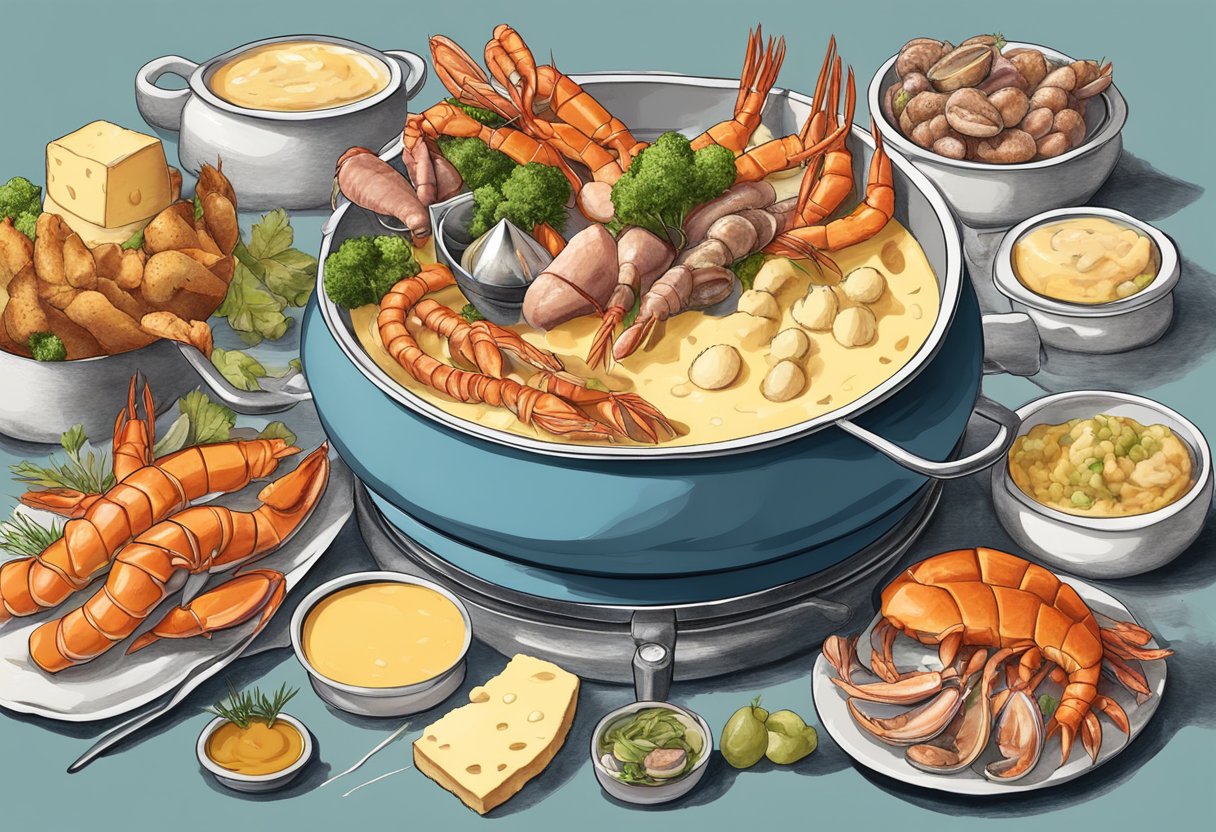
Before we dive into the specifics, let’s acknowledge the impact that the right choice of meat and seafood can have on the fondue experience. Picking the right items for dipping can elevate the meal to a new level.
Choosing Meats for Fondue
When selecting meats for cheese fondue, we recommend opting for those that complement the richness of the cheese without overpowering it. Here’s our succinct guide:
- Beef: Choose tender cuts like sirloin, cut into bite-sized cubes for quick cooking.
- Chicken: Ensure it’s fully cooked prior to fondue; it pairs well with creamy cheese.
- Cured Meats: Thinly sliced salami, prosciutto, and other cured meats offer a deliciously salty contrast.
- Sausage and Bacon: Pre-cook these for a smoky flavor that stands up to robust cheeses.
Remember, meats should be cooked according to safety guidelines before dipping.
Best Seafood for Cheese Fondue
Seafood can be a superb addition to cheese fondue with its delicate flavors. We recommend the following:
- Shrimp: Pre-cooked or grilled, shelled shrimp dip well and taste great.
- Crab: Lump crab meat lends a sweet flavor that pairs beautifully with cheese.
- Lobster: Succulent pieces of cooked lobster tail make for an indulgent dip.
For the best experience, always ensure seafood is fully cooked and warm for a smooth fondue experience.
Vegetable Dippers
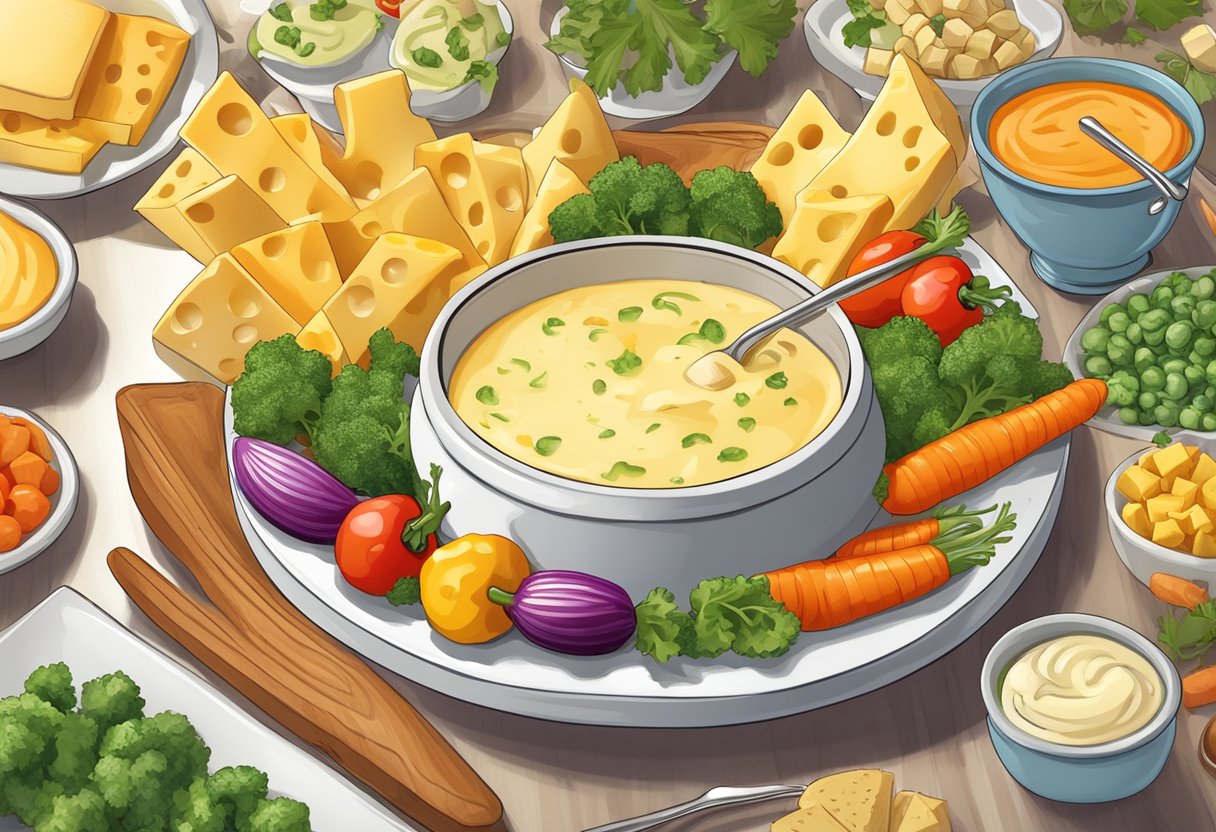
When we think of dipping into cheese fondue, vegetables are a fresh and flavorful option that can enhance the experience. They offer a crisp counterbalance to the rich cheese.
Raw Vegetables
Raw vegetables provide a fresh crunch that pairs delightfully with the creamy texture of fondue. Here’s a list of some ideal raw vegetables to dip:
- Broccoli: Bite-sized florets capture cheese perfectly.
- Cauliflower: Similar to broccoli, its nooks hold onto cheese.
- Bell Peppers: Slices of colorful bell peppers give a sweet, juicy crunch.
- Carrots: Stick-cut carrots add a pleasant earthy sweetness.
- Cherry Tomatoes: Whole cherry tomatoes burst with juiciness.
- Cucumber: Thick slices ensure a refreshing bite.
- Radishes: Their peppery bite offers a nice contrast to the cheese.
Blanched or Cooked Vegetables
Blanching or lightly cooking certain vegetables enhances their flavor and makes them tender, which can be a better match for fondue. Here is a brief guide:
- Baby Potatoes: Boiled until tender, they are a classic fondue companion.
- Green Beans: Blanching retains their snap and bright color.
- Asparagus: Lightly steamed or grilled to maintain a bit of crunch.
- Brussels Sprouts: Roasted until just tender, they’re full of flavor.
- Mushrooms: Sauteed lightly, mushrooms become succulent.
- Spinach: Wilted leaves can be rolled, making them easier to dip.
- Zucchini: Slices blanched or grilled remain slightly firm.
- Artichoke Hearts: Marinated and cooked until tender, they’re wonderfully tangy.
- Pearl Onions: Cooked until they’re soft, yet still hold their shape for dipping.
Fruits and Sweet Dippers
When incorporating fruits into cheese fondue, we focus on selecting ones that complement the cheese’s richness and providing a variety of dessert dipping ideas to satisfy that sweet tooth.
Choosing Fruits
Fruit choices are crucial when pairing with cheese fondue. We recommend:
- Apples: Choose firm varieties like Granny Smith for their tartness, which cuts through the fondue’s creaminess.
- Pears: Similarly, pears bring a subtle sweetness that meshes well with gooey cheese.
- Pineapple: Tropical and tangy, pineapple adds a zesty flavor twist to the fondue experience.
When preparing fruits for dipping, it is wise to slice them into bite-sized pieces for ease of eating.
Dessert Dipping Ideas
For a sweet take on fondue, we suggest the following combinations:
- Granny Smith apples dipped in a mild, creamy cheese fondue. Their sourness contrasts the cheese’s richness beautifully.
- Pears, when used with a stronger cheese like Gruyère, create a sophisticated flavor duo that’s sure to impress.
- Pineapple chunks offer a surprising pop of acidity and sweetness, cutting through heavier cheese blends.
By carefully selecting fruits with contrasting flavors and textures, we craft a fondue experience that balances indulgence with refreshing bites.
Additional Dipping Ideas
When we think beyond the traditional bread and vegetables, a world of exciting flavors opens up for cheese fondue. We’ve curated a list of additional dipping items that pair delightfully with the creamy texture and rich taste of fondue.
Crunchy Add-ons:
- Potato Chips: Their crispness and slight saltiness add a pleasant contrast to the smooth cheese dip.
- Pretzels: With their classic knotted shape, pretzels are not just fun to eat but also carry a subtle malt flavor that complements cheese fondue.
Table 1: Savory Pairings
| Savory Ingredient | Description | Why it Works |
|---|---|---|
| Potato Chips | Salty, crunchy | Texture contrast, saltiness |
| Pretzels | Crunchy, slightly malted | Complementary flavors |
Textural Delights:
Consider these for a variety of textures and flavors:
- Cornstarch-coated items can offer a unique texture when dipped. However, we usually use cornstarch to thicken fondue rather than as a dipping item.
- Experiment with pickled items like dill pickles and cornichons for a tangy bite that cuts through the richness of the cheese.
Table 2 highlights the zesty elements that can refresh our palate:
| Zesty Ingredient | Description | Why it Works |
|---|---|---|
| Dill Pickles | Sour, crunchy, with a dill aroma | Acidity balances cheese richness |
| Cornichons | Tiny, tart, and crunchy | Their small size makes for perfect bites |
Remember, the key to an excellent fondue experience is in the variety of flavors and textures we bring to the table. By incorporating these additional items, we ensure every dip into the cheese is both familiar and thrillingly new. Enjoy the exploration of these pairings at our next fondue feast.
Flavor Enhancers and Spices
When it comes to perfecting cheese fondue, we understand that flavor enhancers and spices play a pivotal role in creating a truly delectable experience. Our choice of spices, herbs, and liquids can transform the fondue from good to great.
Flour acts as a stabilizer for our fondue. A tablespoon or two, depending on the fondue size, ensures a smooth consistency, but it’s important to whisk it thoroughly to prevent clumping.
As for spices, a pinch of salt can accentuate the cheese’s natural flavors. Pepper, freshly ground, offers a subtle bite that counters the richness. Incorporating harmonious herbs such as thyme or rosemary elevates our fondue with aromatic depth.
We often prefer using dry white wine as a base for its acidity, which balances the fondue’s creaminess. The choice of wine is essential — a good quality variety enhances the overall taste profile. If wine isn’t preferred, we might opt for beer, creating a more robust, earthy character.
Brandy or other alcohol can be introduced to introduce complexity to our fondue. A splash is sufficient; it not only enriches flavor but also helps the cheese melt more smoothly. The alcohol should effortlessly blend with the other components without overpowering them.
Lastly, adding a bit of lemon juice provides a touch of brightness, cutting through the fondue’s richness. When we blend these elements thoughtfully, our cheese fondue becomes an aromatic and flavorful centerpiece that entices all the senses.
Pairing Drinks with Cheese Fondue
When indulging in cheese fondue, selecting the right drink to complement the experience is crucial. We prefer white wine as it pairs harmoniously with the creaminess of the cheese. A classic choice is a dry, crisp white such as Sauvignon Blanc or a Swiss Fendant. These wines have the acidity needed to cut through the richness of the fondue.
For those who enjoy red wine, a light-bodied variety works best to avoid overpowering the cheese. A Pinot Noir, with its subtle flavors, can be a delightful accompaniment. As the fondue tends to be heavy, a red wine with high tannins might not be the most suitable option.
Beer aficionados need not feel left out. A good beer can also complement your fondue experience. Opt for a pale ale or wheat beer; their effervescence and slight bitterness provide a refreshing contrast to the fondue’s creamy texture.
Here is a simple guide to help you pair your cheese fondue with the appropriate drink:
| Cheese Fondue Type | Recommended White Wine | Recommended Red Wine | Recommended Beer |
|---|---|---|---|
| Traditional Swiss Fondue | Fendant or Sauvignon Blanc | Light-bodied Pinot Noir | Pale Ale |
| Creamy Cheddar Fondue | Chardonnay | Gamay | Wheat Beer |
| Blue Cheese Fondue | Riesling | Beaujolais | Brown Ale |
Remember, the key to a perfect pairing is balance. The drink should neither overshadow the taste of the fondue nor be lost in its powerful flavors. We suggest sampling the drink with your fondue to find your ideal match. Enjoy your fondue and drink pairing responsibly!
After the Party
Once the last guest has left and the party’s lively chatter has faded, we turn our attention to dealing with leftovers and cleaning up. Our goal is to handle food safely and maintain our fondue pot for future use.
Handling Leftovers
If we find ourselves with leftover cheese fondue, it’s imperative to store it properly. We allow the fondue to cool completely before transferring it to an airtight container. It can then be refrigerated for up to 3 days. For a buttery cheese fondue, separation may occur, so a gentle reheat while whisking can help regain the smooth texture.
When it comes to chocolate fondue, refrigeration can help keep it for later enjoyment. We pour leftover chocolate fondue into a container and refrigerate. To reuse, simply reheat the chocolate in a microwave at half-power, stirring every 30 seconds until smooth.
Cleaning the Fondue Pot
Cleaning the fondue pot efficiently will ensure its longevity and readiness for the next gourmet adventure.
-
Non-cheese residues: If our fondue pot hosted chocolate, we wipe out any remnants with a paper towel while the pot is still warm, as this will be easier than when the leftover chocolate hardens.
-
Cheese residues: Soak the pot with hot water and a mild detergent to loosen the cheese. We use a non-abrasive sponge to protect the pot’s surface and avoid scratching.
Material Cleaning Method Ceramic Gentle hand washing with soapy water Cast Iron Warm water rinse, dry immediately Non-stick Soft sponge with soapy water, rinse thoroughly -
It’s important to avoid harsh cleansers or scrubbers that could damage the pot.
After drying, we store the fondue pot in a dry place, ensuring it’s covered or wrapped to protect from dust. By following these steps, we keep our fondue pot in top shape, making our next fondue experience just as delightful.
Health Considerations
When indulging in cheese fondue, it’s important for us to consider its nutritional impact, especially if we have dietary restrictions or are calorie-conscious.
Calorie Content: Cheese fondue can be high in calories, primarily due to the cheese and dipping ingredients. We recommend opting for lower-calorie dippers such as vegetables to balance out the meal. Here’s a simple breakdown:
- Cheese: High in calories, but also offers protein and calcium.
- Bread: Often a staple dipper, bread can add significant calories; choosing whole-grain can provide added fiber.
- Vegetables: Carrots, bell peppers, and broccoli offer a nutritious, lower-calorie choice.
Dietary Restrictions: We should be mindful of guests who may have specific dietary needs. For those who are lactose intolerant, lactose-free cheeses are available. Additionally, gluten-free bread can be provided for guests with gluten sensitivities.
- Lactose-Free Options: Cheeses like Cheddar, Swiss, and Parmesan are naturally lower in lactose.
- Gluten-Free Alternatives: Aside from gluten-free bread, one can dip rice crackers or use vegetables.
It’s also wise for us to consider the sodium content in cheese, which might be a concern for those monitoring their salt intake.
When preparing cheese fondue, it is prudent to cater to various dietary requirements while balancing flavor and enjoyment. By making conscious choices about what we dip in our fondue, we can create an enjoyable experience that is also considerate of health considerations.
Tips for a Successful Fondue Experience
To ensure a fondue that is both creamy and delightful, we must pay attention to the quality of the cheese. The choice of cheese is critical; it should melt smoothly, providing a rich and uniform texture. A combination of cheeses often works best, like Gruyère mixed with Emmental, which ensures both flavor and creaminess.
When melting the cheese, gentle heat is our ally. We must avoid rushing the melting process, as high heat can cause the cheese to separate and become clumpy rather than creamy. Stirring continuously in a figure-eight motion allows for even melting and prevents sticking.
For our dippers, to complement the velvety texture of melted cheese, we aim for a balance of crunchy and soft options. Bread is a classic choice; however, we opt for slightly stale, denser bread that holds up better to dipping. Pieces should be bite-sized, with some crust for added texture.
| Dipper Category | Suggested Dippers |
|---|---|
| Crunchy | Apple slices, bell pepper, broccoli |
| Soft | Boiled potatoes, steamed cauliflower |
We avoid using overly soft or crumbly items that could disintegrate in the fondue. For a more diverse experience, we can also introduce an array of vegetables and fruits; these not only create a flavorful contrast but bring a refreshing crunch to the palate.
Finally, it’s essential to prepare our fondue pot and keepers right before serving to maintain the ideal consistency of the melted cheese. We do not let the fondue sit for too long as it can thicken and lose its smooth texture. By applying these simple yet effective practices, we ensure that our cheese fondue experience is nothing short of spectacular.
Shopping List and Preparation
When we prepare for a cheese fondue, our shopping list is crucial. We aim to gather a variety of ingredients that pair perfectly with the rich, creamy dip.
Cheeses:
- Gouda
- Fontina
- Swiss Cheese
We ensure to choose high-quality cheeses. This trio offers a lovely balance of flavors and textures for our fondue.
Dippers:
- French Bread
- Apples
- Vegetables (such as broccoli and carrots)
- Cooked meats (like chicken and sausage)
Our preparation starts by cutting the bread into bite-sized cubes, allowing the crust to remain for added texture. For the apples and vegetables, we wash and slice them into manageable pieces. Apples are best when slightly tart, to complement the cheese’s richness.
| Ingredients | Preparation |
|---|---|
| Bread | Cut into cubes |
| Apples | Slice into wedges |
| Vegetables | Wash and cut |
| Cooked Meats | Slice or leave in small pieces |
Before beginning the fondue process, we cube or shred our chosen cheeses—gouda, fontina, and Swiss cheese—so they’ll melt evenly when we heat them. Prepping everything beforehand allows us to relax and enjoy our fondue experience without interruptions.
It’s essential for us to consider the order of cooking. Start by rubbing a garlic clove around the fondue pot for subtle aroma, then gently heat the wine or beer base before incorporating the cheeses. Stir constantly for a smooth, lump-free fondue. Following these steps assures us a smooth and enjoyably fondue experience.
Troubleshooting Common Fondue Issues
Consistency Challenges
If your fondue is too thick, it can be difficult to dip items effectively. To thin it out, we can add a bit of white wine, lemon juice, or warm water—and stir gently until we achieve the desired consistency. On the other hand, if the fondue is too thin, we’ll need to thicken it by adding more cheese that’s blended with a bit of cornstarch or flour.
Temperature Control
Maintaining the right temperature is crucial for ideal fondue texture. If the fondue is too hot, it may burn or become clumpy. To address overheating, we should lower the heat on our fondue burner or if using an electric fondue pot, adjust the temperature setting. A fondue that’s too cold, however, can cause the cheese to seize up and become stringy. To warm it up, we gently increase the heat and stir until it’s suitably melted.
Quick Fixes:
-
Cheese not melting? Gradually increase heat and stir frequently.
-
Fondue burning on the bottom? Reduce heat and stir. If it persists, transfer to a new pot.
-
Separation occurring? Whisk in a tablespoon of lemon juice or cornstarch slurry to re-emulsify.
By using these tactics, we can ensure our cheese fondue maintains the perfect texture and temperature for dipping.
Fondue Etiquette
When participating in a fondue dining experience, adherence to certain etiquette ensures a pleasant meal for everyone involved. It’s important to follow these conventions:
- Double-dipping: We avoid double-dipping. After taking a bite, the portion of your dipping item that has touched your mouth should not be re-submerged into the communal cheese.
- Dipping tools: Use the fondue forks provided for dipping. These should never be used for eating directly; transfer your dipped items onto your plate first.
- Communal pot manners: We never touch the communal pot with our hands.
- Fondue fork etiquette: When dipping, be considerate of others. We dip one at a time when the pot is crowded.
- Dropped items: If an item falls into the fondue, it’s common to have a playful penalty, such as singing a song. This keeps the mood light.
Here’s a succinct guide to proper fondue fork usage:
| Step | Action |
|---|---|
| 1. Spear | Use your fondue fork to spear the item you’re dipping. |
| 2. Dip | Submerge the item into the cheese fondue. |
| 3. Transfer | Transfer the dipped item onto your personal plate. |
| 4. Eat | Use a regular fork to eat the item from your plate. |
Remembering these basic rules will help us maintain good fondue etiquette and ensure that everyone enjoys their meal harmoniously and hygienically.
Recipes and Variations
When preparing cheese fondue, we often opt for traditional recipes that call for a blend of Gruyère and Emmentaler cheeses. These semi-hard Swiss cheeses are renowned for their excellent melting properties and distinct flavors that are both nutty and creamy—an ideal foundation for a delectable fondue.
Classic Cheese Fondue:
Ingredients:
- 8 oz Gruyère cheese, shredded
- 8 oz Emmentaler cheese, shredded
- 1 clove garlic, halved
- 1 cup dry white wine
- 1 tablespoon lemon juice
- 2 teaspoons cornstarch
- 1 tablespoon kirsch (optional)
- Freshly ground pepper and nutmeg to taste
Directions:
- Rub the inside of the fondue pot with the garlic halves.
- Pour in the white wine and lemon juice; heat until hot, but not boiling.
- Gradually add the cheese, stirring until melted and smooth.
- Dissolve cornstarch in kirsch and blend into the cheese mixture.
- Season with pepper and nutmeg, continuing to stir until thickened and creamy.
To diversify our fondue experience, we explore variations by infusing different flavors or by substituting cheeses. For instance, we might introduce smoked Gouda or sharp Cheddar for a twist on the classic taste. When adapting the base recipe, we maintain a balance by choosing cheeses that melt well and complement each other.
Variation Ideas:
- Add smoked paprika or caramelized onions for a savory touch.
- Mix in chopped herbs such as chives or tarragon for freshness.
- For a spicy kick, include a dash of cayenne pepper or diced jalapeños.
Remember that the key to a successful cheese fondue lies in the quality of the ingredients we choose and how we marry them together. Our creativity in pairing various dippers—from bread cubes to vegetables—allows us to enjoy a range of textures and tastes that elevate the fondue experience.
Hosting a Themed Fondue Night
When we plan a themed fondue night, the first step is deciding on the theme. Our theme could be inspired by a specific country, such as a Swiss or French night, or decade-related, like the groovy ’70s. The chosen theme will guide the decorations, music, and even the types of cheese we select for our fondue.
Decorations:
- Swiss Night: Red and white tablecloths, small flags, and mountainous backdrops.
- French Night: Eiffel Tower centrepieces, strings of lights, and blue, white, and red accents.
- ’70s Night: Lava lamps, disco balls, and psychedelic colors.
Music:
- Tailor the playlist to fit the era or country. If it’s a ’70s night, for instance, we’ll queue up some classic hits from that decade.
Cheese Choices:
- Swiss Night: Gruyère and Emmental.
- French Night: Brie and Comté.
- ’70s Night: A retro-inspired mix, including Cheddar and Swiss.
Attire:
- Encourage guests to dress according to the theme for extra fun. Lederhosen for a Swiss night would be a hit!
Invitations: Send out themed invites that match the fondue night motif. If we opt for a ’70s theme, think bright colors and funky fonts.
Activities:
- Swiss Night: A chocolate fondue finale for dessert.
- French Night: A wine tasting paired with the various cheeses.
- ’70s Night: A mini disco dance-off post-dinner.
Keeping the night anchored to our chosen theme not only makes the experience memorable but also gives us a fun framework when selecting our dippables, from crusty bread and charcuterie to fresh vegetables and fruits.
Exploring Regional Fondue Traditions
When we look at cheese fondue traditions, we find a wealth of regional varieties that reflect local tastes and cheese-making practices. In the Swiss Alps, for instance, Gruyère and Vacherin are staple cheeses, giving the fondue a rich and smooth flavor. On the other hand, Emmental cheese adds a distinct, slightly nutty taste.
| Region | Cheeses Commonly Used | Typical Dippers |
|---|---|---|
| Switzerland | Gruyère, Vacherin, Emmental | Bread cubes, potatoes, pickles |
| France | Comté, Beaufort, Emmental | Crusty baguette, apples, charcuterie |
| Italy | Fontina, Gorgonzola | Polenta cubes, grilled vegetables, breadsticks |
In France, especially near the border with Switzerland, fondue takes on a Gallic twist with Comté and Beaufort. French dippers often include pieces of a crusty baguette, and for an added flavor dimension, we might even find ourselves dipping tart apple slices or various charcuterie.
Crossing the border into Italy, particularly in the Aosta Valley, we see Fontina cheese frequently used to create a fondue with a distinct, mild yet creamy taste. In this region, fondue might be accompanied by rustic polenta cubes, hearty grilled vegetables, or crispy breadsticks.
While we observe these regional practices, we also recognize that the beauty of fondue lies in its versatility. Each locale lends its unique touch to the fondue experience, allowing us to savor a variety of textures and flavors. Whether in Switzerland, France, or Italy, the essence of dipping into a communal pot of melted cheese remains a cherished tradition that continues to bring people together.
Fondue and Cultural Significance
Fondue is not merely a dish but a culinary tradition steeped in cultural significance. Originating from Switzerland, fondue has become a symbol of communal dining and national pride. It traditionally represents a way to use aged cheeses and stale bread during the winter months. The act of sharing a pot of melted cheese reinforces a sense of community and togetherness among those partaking in the meal.
Components of Fondue Dining:
- Communal Pot: A single pot serves the entire group, fostering a communal dining experience.
- Long-Stemmed Forks: Each person has their own fork to dip bread and other items into the cheese.
- Rotating Selection of Dips: Diversified items to dip, ranging from bread to vegetables and meats.
In Switzerland, fondue etiquette and customs are taken seriously, and there are often playful penalties for those who drop their bread in the pot—usually involving tasks that contribute to the light-hearted atmosphere of the meal.
| Swiss Fondue Values | Description |
|---|---|
| Hospitality | Sharing a fondue pot welcomes guests warmly. |
| Equality | Everyone eats from the same pot, symbolizing equality. |
| Enjoyment | Savoring the moment and the shared experience. |
We recognize that fondue embodies a cultural ritual that extends beyond the boundaries of its Swiss origins. It has traversed the globe, integrating into various cultures while preserving its core ethos of shared dining. It represents a blend of simplicity and sophistication, a dish that brings people together. Through fondue, we participate in a historical tradition that has been cherished across generations and continues to be celebrated for its convivial essence.
Innovative Fondue Fusion Ideas
When we think of cheese fondue, traditional dippers like bread cubes and vegetables often come to mind. However, we’re here to expand your culinary horizons with fusion ideas that combine the comforting warmth of melted cheese with unexpected global flavors. Our suggestions aim to inspire an adventurous fondue experience.
Asian Twist:
- Steamed Bao Buns: Bite-sized and fluffy, ready to soak up the cheese.
- Sushi Rolls: Opt for vegetable or tempura rolls, avoiding fish to prevent clashing flavors.
Mediterranean Flair:
- Falafel Balls: Their crispy exterior and hearty inside pair superbly with gooey cheese.
- Grilled Halloumi: Double down on the cheese love with this firm, grillable variety.
Latin American Zest:
- Empanada Wedges: Stuff with spinach or mushrooms for a hearty dipper.
- Plantain Chips: Their crispiness and subtle sweetness offer a delightful contrast.
Miniature Comfort Foods:
- Mini Grilled Cheese Sandwiches: Classic comfort in a bite-sized form.
- Tiny Meatballs: Seasoned with Italian herbs to complement the cheese’s richness.
We encourage exploration of these unconventional pairings, showcasing how we can bring the world to our fondue pot. The key is to ensure that our chosen dippers are sturdy enough to withstand a dip into the molten cheese, enhancing the overall fondue experience with global gastronomic diversity.
Dipping Technique and Strategy
When preparing to enjoy cheese fondue, we employ specific dipping techniques and strategies to enhance the experience and ensure both safety and enjoyment. Here’s how we approach it.
Pre-dip Preparation:
Before we start, we make sure our dips are of manageable size, neither too large to cool the fondue nor too small to fall off the fork. We also pat dry any juicy items like fruits or vegetables to avoid water seeping into the fondue, which can alter its consistency.
Spear and Dip:
We spear our chosen dipper on the fondue fork firmly. Our dipping movement is a gentle swirl rather than a vigorous stir, which helps keep the fondue smooth and well-mixed.
The Twirl:
Once immersed, we twirl the fork to wrap excess dripping cheese around our item, preventing drops that may cause mess or burn.
| Technique | Description |
|---|---|
| Pre-dip Patting | Dry items to maintain fondue consistency. |
| Gentle Swirl | Mixes without disrupting the fondue base. |
| Fork Twirl | Secures cheese and minimizes drips. |
Dip Etiquette:
We always avoid double-dipping to maintain hygiene. A one-dip policy ensures everyone comfortably enjoys the fondue without any concerns.
Temperature Strategy:
We allow scorching items to cool slightly after dipping. This ensures that we don’t burn our mouths and can taste the full flavor profile of the cheese and dippers.
By following these techniques and strategies, we ensure our cheese fondue experience is enjoyable and communal, keeping the spirit of sharing and pleasure at the forefront.
Safety Precautions for Using a Fondue Set
When using a fondue set, we must prioritize safety to prevent any accidents that can occur from dealing with hot substances and open flames.
Firstly, always place the fondue set on a stable surface away from the edge of the table to avoid it being knocked over. We must ensure that the surface is heat-resistant to prevent any damage.
Before lighting the burner, we check that the room is well-ventilated, as the burner consumes oxygen. We also verify the type of fuel recommended for our fondue burner and use it accordingly to avoid dangerous reactions.
While the fondue is in use, we remember to keep a close watch on children and pets to ensure they stay a safe distance away. Accidental contact with the hot fondue pot or splatters can cause serious injury.
In the event of a flame getting out of control, we urge you to never use water to extinguish it because it can spread the fire, especially if oil-based fondue is being served. We always keep a fire extinguisher or a damp cloth nearby to smother flames if necessary.
When handling the fondue forks or skewers, we are cautious not to puncture the skin, always using them as intended. After use, we allow the fondue set to cool completely before cleaning.
Finally, proper maintenance of our fondue set is crucial. We routinely check for any damage or wear, particularly in the cord or electric elements if we’re using an electric fondue set, and replace any faulty parts promptly.
The Art of Melting Cheese
When we prepare cheese fondue, the melting process is crucial. We start with high-quality cheese, often a mix of Gruyère and Emmental. These cheeses are known for their superior melting qualities. Before we begin, we grate our cheese, as smaller pieces melt more uniformly. It’s essential to note that room temperature cheese melts better, so we take it out of the refrigerator in advance.
Steps to Melt Cheese for Fondue:
- Prepare the Base: We rub a garlic clove around the fondue pot, then add white wine and lemon juice and warm it gently. The acidic components in lemon juice and wine stabilize the cheese, preventing separation and curdling.
- Gradual Addition: We slowly add the grated cheese to the pot while continuously stirring in a zigzag pattern. This technique ensures even melting and prevents clumping.
- Stirring Consistency: As the cheese begins to melt, we maintain a constant stirring motion. We never rush the process, as patient stirring is key to a smooth fondue.
- Monitor the Heat: We keep the heat low. If the cheese is exposed to high temperatures, it risks becoming stringy or forming lumps.
- Thicken the Fondue: Once the cheese has fully melted, we can mix a little cornstarch with kirsch to create a slurry, then blend it into the fondue. This helps to thicken the cheese to the perfect consistency.
| Do | Don’t |
|---|---|
| Use room temperature cheese | Rush the melting process |
| Stir constantly but gently | Overheat the cheese |
| Add cheese gradually | Add all cheese at once |
| Use a fondue pot | Use a regular pot without caution |
By following these guiding principles, we achieve a perfectly smooth and creamy cheese fondue every time. Good melting technique transforms quality ingredients into a delightful dish that’s ready for dipping.
The Bounty of Cheese Fondue Combinations
When we gather around the pot of bubbling cheese fondue, we’re presented with a plethora of dipping possibilities that combine to elevate the experience. Our choices range from the traditional to the unexpected, each bringing its own texture and flavor to meld with the creamy cheese.
Breads:
- Classic French Baguette: Cubed; its crunch contrasts the gooey fondue.
- Sourdough: A tangy choice that complements the cheese’s richness.
Meats:
- Cooked Steak: Tender pieces enhance the fondue’s savory notes.
- Salami: Bold spiced slices offer a variation in taste.
Vegetables:
- Broccoli: Lightly steamed, its earthiness pairs well with the cheese.
- Baby Potatoes: Boiled and providing a satisfying soft bite.
Fruits:
- Apples: Crisp slices cut through the cheese’s density.
- Pears: Their subtle sweetness creates a delightful contrast.
Below is a simple guide for our suggested combinations:
| Bread | Meat | Vegetable | Fruit |
|---|---|---|---|
| French Baguette | Steak | Broccoli | Apples |
| Sourdough | Salami | Baby Potatoes | Pears |
Remember, the joy of cheese fondue lies in exploring the various pairings. We encourage you to create your own unique combinations, mixing and matching ingredients to your preference to discover new favorites.
Frequently Asked Questions
In this section, we address common inquiries about cheese fondue, ensuring you have the knowledge to craft a delightful dipping experience.
What types of bread pair well with cheese fondue?
We find that crusty bread like baguette, ciabatta, and sourdough is ideal for dipping due to its firm texture and ability to soak up the cheese without falling apart.
Can you recommend some dipping items for a cheese fondue meal?
For a well-rounded meal, we suggest vegetables like broccoli, bell peppers, and carrots, along with meats such as cooked sausage or cubed ham. These items complement the rich taste of the cheese fondue.
Which cheeses yield the creamiest fondue mixtures?
We recommend Gruyère and Emmental for their melting qualities and flavor. Adding a bit of cornstarch can help stabilize the mixture for an even creamier consistency.
How can one enjoy cheese fondue without including wine in the recipe?
We substitute chicken or vegetable stock for wine to cater to different dietary preferences while maintaining a delicious fondue base. Lemon juice can also be added for the acidity that wine typically provides.
What are suitable side dishes to accompany a fondue dinner?
We advise serving side dishes such as a crisp green salad, pickled vegetables, or small bowls of olives to balance the richness of the cheese fondue.
Aside from bread, what unconventional items can be dipped in cheese fondue?
We enjoy experimenting with dippers like pear or apple slices, boiled new potatoes, or even gherkins to add unexpected flavors and textures to the fondue experience.

